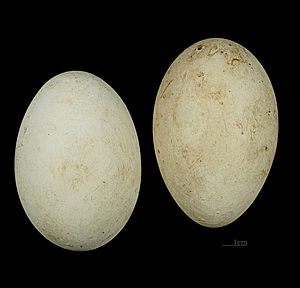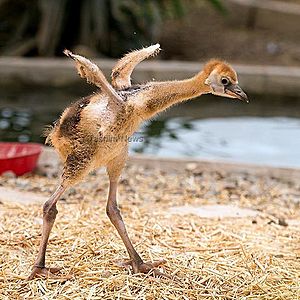Grey crowned crane facts for kids
Quick facts for kids Grey crowned crane |
|
|---|---|
 |
|
| Conservation status | |
| Scientific classification | |
| Kingdom: | |
| Class: | |
| Order: | |
| Family: | |
| Genus: |
Balearica
|
| Binomial name | |
| Balearica regulorum |
|
The grey crowned crane (also called the East African crowned crane) is a beautiful bird. It lives in wet areas of eastern and southern Africa. These cranes can grow up to 3.3 feet (about 1 meter) tall. They can weigh over 7.7 pounds (about 3.5 kg). In zoos, they can live for up to 25 years! They enjoy eating many things. This includes grasses, seeds, insects, and other small creatures.
Contents
What Does a Grey Crowned Crane Look Like?
The grey crowned crane is easy to spot. Its body is mostly grey. Its wings are mostly white, but they have feathers with many different colors. The most special part is its head. It has a crown of stiff, golden feathers. The sides of its face are white. It also has a bright red pouch under its chin that can puff up. This is called a throat pouch.
Its beak is short and grey. Its legs are black and long. These long legs help it walk through tall grasses and water. Its feet are big but thin. They are good for balancing, not for fighting or grabbing things. Male and female cranes look similar. However, males are usually a little bigger. Young cranes are more grey than adults. Their faces are covered in soft, buff-colored feathers.
These cranes are special. They are one of only two crane types that can sleep in trees. They have a long back toe that helps them hold onto branches. Other cranes do not have this ability.
Where Do Grey Crowned Cranes Live?

Grey crowned cranes live in dry grasslands in Africa. You can find them south of the Sahara desert. They like to build their nests in wetter places. They also live in marshes, farms, and grassy areas near rivers and lakes. You can see them in Uganda and Kenya. They live as far south as South Africa.
These birds do not usually migrate long distances. Cranes living closer to the equator tend to stay in one place. Those in drier areas, like Namibia, might move around a bit. They do this to find water during dry times.
Crane Behavior and Habits
Grey crowned cranes have a special way of attracting a mate. They perform a breeding dance! This dance includes bowing and jumping. They also make a loud booming call. This call makes their red throat pouch puff up. They can also make a honking sound. This is different from the loud trumpeting calls of other cranes. Both male and female cranes dance. Even young birds join in the dancing fun. Dancing is a big part of finding a mate. But they can also dance at any time of the year.
Sometimes, you can see large groups of these cranes. Flocks of 30 to 150 birds are common.
What Do Grey Crowned Cranes Eat?
These cranes eat many different things. They are omnivores. This means they eat both plants and animals. Their diet includes plants, seeds, grains, and insects. They also eat frogs, worms, snakes, small fish, and the eggs of water animals.
They have a clever way to find food. They stomp their feet as they walk. This makes insects jump out of the grass. The cranes then quickly catch and eat them. They also like to follow grazing animals. These include antelopes and gazelles. When these animals walk, they stir up insects. The cranes then grab these easy meals. Grey crowned cranes spend their whole day looking for food. At night, they sleep and rest in trees.
Reproduction and Life Cycle
Grey crowned cranes usually breed when it rains. But this can be different depending on where they live. In East Africa, they breed all year. However, they breed most often during drier times. In Southern Africa, they breed when the rains come.
During breeding season, crane pairs build a large nest. It is a platform made of grass and other plants. They build it in tall plants found in wet areas. A female crane lays 2 to 5 shiny, dirty-white eggs. Both parents take turns sitting on the eggs. This is called incubating. It takes about 28 to 31 days for the eggs to hatch. The chicks are very active when they hatch. They can run around right away! They learn to fly in about 56 to 100 days.
Cranes and People
Protecting the Cranes
The grey crowned crane is still common in some areas. But it faces threats to its home. Their habitats are being lost because of drainage (drying out wet areas). Too much grazing by animals and pesticide pollution also hurt them. Experts believe there are between 58,000 and 77,000 of these cranes left. In 2012, their status changed. They went from "vulnerable" to "endangered" by the IUCN. This means they are at high risk of becoming extinct.
A Special Bird
The grey crowned crane is very important to the country of Uganda. It is their national bird! You can see this beautiful crane on Uganda's flag and coat of arms.
Images for kids
See also
 In Spanish: Grulla coronada cuelligr%C3%ADs para niños
In Spanish: Grulla coronada cuelligr%C3%ADs para niños







